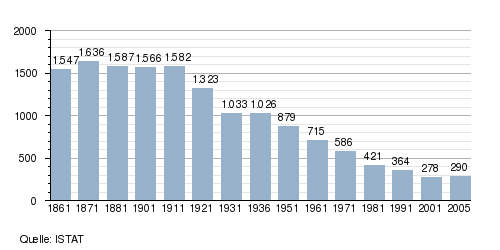Bajardo
| Bajardo | ||
|---|---|---|

|
|
|
| Country | Italy | |
| region | Liguria | |
| province | Imperia (IM) | |
| Coordinates | 43 ° 54 ' N , 7 ° 43' E | |
| height | 900 m slm | |
| surface | 24 km² | |
| Residents | 341 (Dec. 31, 2019) | |
| Population density | 14 inhabitants / km² | |
| Post Code | 18031 | |
| prefix | 0184 | |
| ISTAT number | 008007 | |
| Popular name | Bajardesi | |
 Bajardo |
||
Bajardo is an Italian municipality with 341 inhabitants (as of December 31, 2019) in the province of Imperia in Liguria . In the area and the only noteworthy is DOC - Red Wine Liguria grown - the Rossese di Dolceacqua .
history
The historical center of the mountain village Bajardos has existed since the first millennium BC. Since then, Bajardo has had an eventful history.
Place of worship of the druids
Before the Romans came to exploit it, the top of the mountain served as a druid shrine . Some of the historic stone obelisks have been preserved over the millennia.
In the place of the shrine, a castle was later built, which served as protection for the surrounding village. Then part of this castle castle was replaced by a church in the 7th century.
Towards the end of the last century, in 1887, around a hundred peasants gathered under the arches of this church to celebrate Ash Wednesday before going out into the fields to work. But that didn't happen. During the service, the mountains were shaken by a tremendous earthquake and over a hundred people died when the roof of the church collapsed.
After the earthquake, most people left their houses on the upper mountain slope, although they were not destroyed, and settled again further below. But not all. A medieval house was bought in the 1930s by a family of musicians west of the church on the edge of a terraced ledge.
World War II and its decline
The nation was divided into three camps. The fascists, the partisans who fought against the fascists, and the independents who refused to take sides. The region around Bajardo was a partisan bastion with extremely violent activities. The family of musicians only took notice of their musical instruments and musical life and tried to ignore the war around them. At least until 1944, after a series of threats, she was forced to leave her home in the middle of the night.
Attempts in the last twenty years to try local politics to preserve the real antiquity of Bajardo from final disintegration have been abandoned.
Many houses are still standing today. But the windows are broken in the meantime, the colors and plaster of the facades are peeling off. Wild wine has overgrown the stone and the terraced mountainside. But the walls that have held houses together since the 14th century have remained solid. Tourism has left the village practically untouched.
The rediscovery of Bajardo
Thanks to the initiative of the administration and the municipal council, the village is being restored.
The remaining masonry of the church was preserved to prevent further damage. The top of the mountain is occasionally inhabited again and the remains of houses are being restored or restored.
Demographics
The population development of Bajardo has been marked by a sharp decline since 1911. In 1911, 1582 people lived in the village and in 2005 there were only 278 - this corresponds to a decrease of over 80%.

Individual evidence
- ↑ Statistiche demografiche ISTAT. Monthly population statistics of the Istituto Nazionale di Statistica , as of December 31 of 2019.


